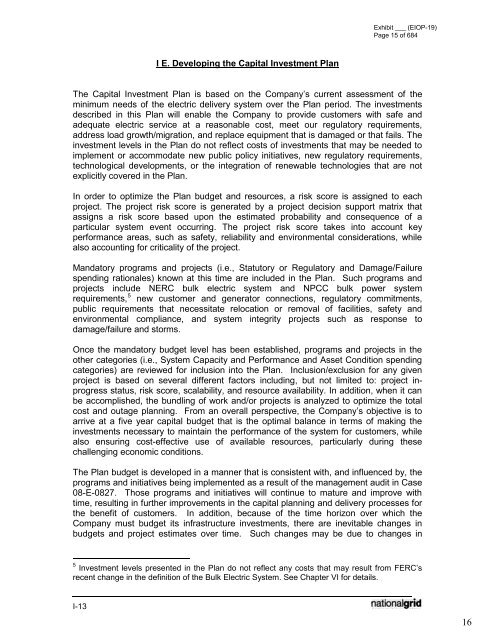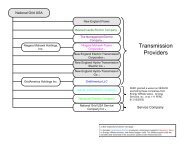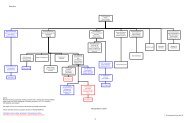January 2012 Capital Investment - National Grid
January 2012 Capital Investment - National Grid
January 2012 Capital Investment - National Grid
Create successful ePaper yourself
Turn your PDF publications into a flip-book with our unique Google optimized e-Paper software.
Exhibit ___ (EIOP-19)Page 15 of 684I E. Developing the <strong>Capital</strong> <strong>Investment</strong> PlanThe <strong>Capital</strong> <strong>Investment</strong> Plan is based on the Company’s current assessment of theminimum needs of the electric delivery system over the Plan period. The investmentsdescribed in this Plan will enable the Company to provide customers with safe andadequate electric service at a reasonable cost, meet our regulatory requirements,address load growth/migration, and replace equipment that is damaged or that fails. Theinvestment levels in the Plan do not reflect costs of investments that may be needed toimplement or accommodate new public policy initiatives, new regulatory requirements,technological developments, or the integration of renewable technologies that are notexplicitly covered in the Plan.In order to optimize the Plan budget and resources, a risk score is assigned to eachproject. The project risk score is generated by a project decision support matrix thatassigns a risk score based upon the estimated probability and consequence of aparticular system event occurring. The project risk score takes into account keyperformance areas, such as safety, reliability and environmental considerations, whilealso accounting for criticality of the project.Mandatory programs and projects (i.e., Statutory or Regulatory and Damage/Failurespending rationales) known at this time are included in the Plan. Such programs andprojects include NERC bulk electric system and NPCC bulk power systemrequirements, 5 new customer and generator connections, regulatory commitments,public requirements that necessitate relocation or removal of facilities, safety andenvironmental compliance, and system integrity projects such as response todamage/failure and storms.Once the mandatory budget level has been established, programs and projects in theother categories (i.e., System Capacity and Performance and Asset Condition spendingcategories) are reviewed for inclusion into the Plan. Inclusion/exclusion for any givenproject is based on several different factors including, but not limited to: project inprogressstatus, risk score, scalability, and resource availability. In addition, when it canbe accomplished, the bundling of work and/or projects is analyzed to optimize the totalcost and outage planning. From an overall perspective, the Company’s objective is toarrive at a five year capital budget that is the optimal balance in terms of making theinvestments necessary to maintain the performance of the system for customers, whilealso ensuring cost-effective use of available resources, particularly during thesechallenging economic conditions.The Plan budget is developed in a manner that is consistent with, and influenced by, theprograms and initiatives being implemented as a result of the management audit in Case08-E-0827. Those programs and initiatives will continue to mature and improve withtime, resulting in further improvements in the capital planning and delivery processes forthe benefit of customers. In addition, because of the time horizon over which theCompany must budget its infrastructure investments, there are inevitable changes inbudgets and project estimates over time. Such changes may be due to changes in5 <strong>Investment</strong> levels presented in the Plan do not reflect any costs that may result from FERC’srecent change in the definition of the Bulk Electric System. See Chapter VI for details.I-1316
















